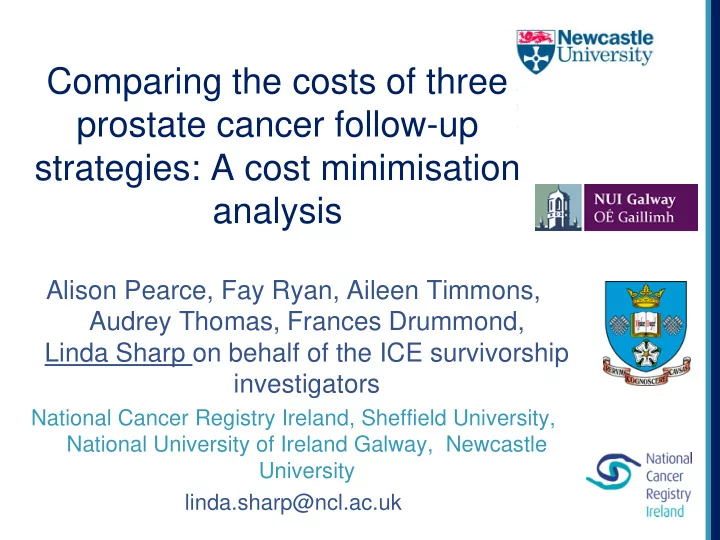

Comparing the costs of three prostate cancer follow-up strategies: A cost minimisation analysis Alison Pearce, Fay Ryan, Aileen Timmons, Audrey Thomas, Frances Drummond, Linda Sharp on behalf of the ICE survivorship investigators National Cancer Registry Ireland, Sheffield University, National University of Ireland Galway, Newcastle University linda.sharp@ncl.ac.uk
Disclosure • No disclosures • Health Research Board funded modelling project (ICE/2012/9) • Health Research Board, Prostate Cancer UK, Irish Cancer Society funded data collection
More men are living with prostate cancer than any other form of cancer Prostate cancer 23,996 (44%) Colorectal cancer 8,207 (15%) Lung cancer 1,969 (4%) • population 4.6 million • 793,000 men aged 45+ Sharp et al. BMC Cancer 2014; 14: 767
Prostate cancer follow-up • Traditionally provided in hospital by clinicians • May not be sustainable – especially in countries with publically-funded healthcare • Alternative models of follow-up – appear to have equivalent clinical efficacy and quality-of-life outcomes to tradition follow-up – starting to be recommended in guidelines – BUT limited evidence on cost implications Lewis et al. Br J Gen Pract 2009; 59: 234-47; Lewis et al. J Adv Nurs 2009; 65: 706-23; McIntosh HM et al. Br J Cancer 2009; 100: 1852-60; Howells et al. J Cancer Surviv 2012; 6: 359-71
Objective To develop an economic model to compare the costs of three alternative strategies for prostate cancer follow-up in Ireland: • European Association of Urology (EAU) guidelines • National Institute of Health & Clinical Excellence (NICE) guidelines • current practice
Methods 1: Follow-up policies Policy PSA testing Setting EUA guidelines Year 1: 3, 6, 12 months Hospital-based clinician Years 2 & 3: every 6 months Year 4 onwards: every 12 months NICE guidelines Years 1 & 2: every 6 months Hospital-based clinician initially. If stable Year 3 onwards: every 12 PSA and no physical or psychosocial months complications after 2 years, follow-up in primary care (GP/nurse). Current practice* Year 1: every 4 months PSA performed by GP and results Year 2: every 6 months provided by hospital-based clinician Year 3 onwards: every 12 initially. If stable PSA after 5 years, months follow-up in primary care (GP). • Mottet N et al. European Association of Urology, 2014 • NICE Clinical Guideline 175, 2014 • Survey of urologists and radiotherapists
Methods 1 Model states: based on patient health status • Markov model and provider of follow-up – follow cohort of 1000 men aged 66 treated with curative intent over 10 Clinician-led: years, through range of “states” Physical accruing costs in each state problems – done for each of 3 arms Clinician-led: • Healthcare payer Asymptomatic 1 year perspective Clinician-led: Death or • Psychosocial Cost minimisation analysis recurrence problems – Clinician-led: assume health outcomes in model Asymptomatic 2 arms are not significantly different years 1,2 • Probabilities of physical or Clinician-led: psychosocial problems Physical and Psychosocial – large surveys of prostate cancer problems survivors in Ireland (EQ-5D-5L) • Costs – UK reference costs Primary care-led follow-up 1,3 – discounted at 5% • Sensitivity analyses – one-way and probabilistic
Results 1: Cost per policy Policy Cost of follow-up % of current per survivor practice costs € 1057 EUA guidelines 92% € 853 NICE guidelines 74% € 1150 Current practice -
Results 2: Costs by year Cost of follow-up care per survivor per year
Results 3: Cost savings Savings compared to current practice over a 10 year period Savings for one year cohort of survivors € 761,119 € 800,000 € 700,000 € 600,000 € 500,000 € 400,000 € 236,959 € 300,000 € 200,000 € 100,000 € 0 EAU guidelines NICE guidelines
Results 4: Sensitivity analyses
Summary & Conclusions • First comparison of costs of alternative prostate cancer follow-up models • Limitations: context specific; model simplifies reality; assumption of same clinical efficacy and quality-of-life outcomes with different policies; not all follow-up models considered • Current practice least cost-efficient option • Cost savings could be possible with follow-up strategies which offer less frequent PSA testing, greater involvement of primary care, and discharge from hospital follow-up for survivors without complications – (aspects) consistent with findings of economic evaluations of breast and colorectal cancer follow-up in Europe* • Additional dimension on debate regarding the purpose and “structure”/organisation of cancer follow -up Koinberg et al. Acta Oncol 2009; 48: 99-104; Lu et al. Br J Surg 2012; 99: 1227-33; Augestad et al. BMJ Open 2013; 3; 1-14
Acknowledgements • Colleagues at National Cancer Registry Ireland who provided data and assisted with survey administration • Follow-up After Cancer Treatment (FACT) Advisory Group and Pamela Gallagher, Michal Molcho , Ciaran O’Neill, Marita Hennessy, Sophie Whyte
Recommend
More recommend